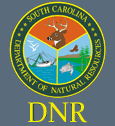Program Summary
Introduction
 The South Carolina Department of Natural Resources (SCDNR) and the South Carolina Department of Health and Environmental Control (SCDHEC) initiated a major new collaborative coastal monitoring program in 1999 entitled the South Carolina Estuarine and Coastal Assessment Program (SCECAP). The goal of SCECAP is to monitor the condition of the state's estuarine habitats and provide periodic reports to both coastal managers and the public. The program collects multiple measures of water quality, sediment quality, and biological condition at a large number of sites throughout the state's coastal zone each year and integrates those measures into an overall assessment of estuarine habitat condition at each site and the entire state. The program also expands historical monitoring activities that have primarily focused on open water habitats (e.g. bays, sounds, tidal rivers) to include an assessment of conditions in tidal creeks, which serve as important nursery habitat for most of the state's economically valuable species. Many of these tidal creeks are also the first point of entry for upland runoff and therefore can provide an early indication of stress related to coastal development, agriculture and industrial activities. (Holland et al., 1997; Sanger et al., 1999a,b; Lerberg et al., 2000; Van Dolah et al., 2000).
The South Carolina Department of Natural Resources (SCDNR) and the South Carolina Department of Health and Environmental Control (SCDHEC) initiated a major new collaborative coastal monitoring program in 1999 entitled the South Carolina Estuarine and Coastal Assessment Program (SCECAP). The goal of SCECAP is to monitor the condition of the state's estuarine habitats and provide periodic reports to both coastal managers and the public. The program collects multiple measures of water quality, sediment quality, and biological condition at a large number of sites throughout the state's coastal zone each year and integrates those measures into an overall assessment of estuarine habitat condition at each site and the entire state. The program also expands historical monitoring activities that have primarily focused on open water habitats (e.g. bays, sounds, tidal rivers) to include an assessment of conditions in tidal creeks, which serve as important nursery habitat for most of the state's economically valuable species. Many of these tidal creeks are also the first point of entry for upland runoff and therefore can provide an early indication of stress related to coastal development, agriculture and industrial activities. (Holland et al., 1997; Sanger et al., 1999a,b; Lerberg et al., 2000; Van Dolah et al., 2000).
Sampling Activities:
The sampling and analytical methods used for SCECAP are fully described in the first SCECAP report covering the 1999-2000 survey (Van Dolah et. al., 2002a). More abbreviated and updated methods are also provided in the 2001-2002 Survey (Van Dolah et. al., 2004), the 2003-2004 Survey (Van Dolah et. al., 2006), and the 2005-2006 Report (Berquist et. al., 2009) when some protocols were changed. Descriptions of the SCECAP sampling design, parameters sampled, and general analytical approach are summarized throughout this website and in the above reports. In general, this program utilizes methods consistent with SCDHEC's water quality monitoring programs (SCDHEC, 2001a) and the USEPA's National Coastal Assessment Program (USEPA, 2001).
Reporting Goals:
Bi-annual "State of the Estuary" reports summarizing the overall condition of South Carolina's coastal system are prepared in formats that are easy to understand by the general public. These reports are produced approximately 2 years after each sampling period is completed in order to provide adequate time to process the large volume of samples collected each summer. Data are also provided as electronic files on this SCECAP website as they become available.
Although the probability-based sampling approach is not intended to provide a trend analysis at specific sites over time, this state-wide database can be used to evaluate changes in the overall percentage of our estuarine habitat that meets, or does not meet, desired levels of condition each year. Many estuaries can also be analyzed at the basin level, once a sufficient number of sites representing each habitat type (open water and tidal creek) have been sampled.
Other Cooperators:
The U.S. Environmental Protection Agency (USEPA) National Health and Environmental Effects Research Laboratory (NHEERL) in Corvallis, Oregon, has been working with SCDNR and SCDHEC staff to provide the technical support for locating the sampling sites each year using the probability based sampling design, and providing the statistical routines necessary for extrapolating the data to provide estimates of overall condition in the states coastal habitats, with confidence limits. The USEPA National Coastal Assessment Program has also provided a substantial portion of the funding in support of SCECAP through 2006.
The National Oceanic and Atmospheric Administration (NOAA) Center for Coastal Environmental Health and Biomolecular Research (CCEHBR), and the NOAA Hollings Marine Laboratory (HML) are also cooperating by providing technical analytical services related to sediment and tissue contaminants and their effects on biota.
The SCDHEC Office of Ocean and Coastal Resource Management (OCRM) has also provided funding to support SCECAP for many of the survey periods completed to date. Other sources of support have included the U.S. Fish and Wildlife Service (USFWS) through their "Federal Aid in Sport Fish Restoration Program", the South Carolina Saltwater Recreational Fisheries License funds, and other revenue funds.
Anticipated Benefits:
The SCECAP program, combined with the other cooperating programs, provides a number of direct and indirect benefits to the citizens of South Carolina. These include:
- The ability to identify areas of South Carolina's estuarine habitat that are impaired or degraded with respect to a suite of sensitive biological, chemical, and physical measures.
- A standardized protocol that is used by both the SCDNR and SCDHEC that is cost-effective and consistent with protocols common among other U.S. coastal states. This allows South Carolina managers to relate conditions in our coastal waters relative to the overall southeastern region, and it allows better regional prioritization of stressors and impacts.
- More comprehensive periodic reports on the condition of water quality and habitat condition throughout the state's coastal zone than could be accomplished by the individual programs alone.
Primary Contacts:
| SCDNR | SCDES |
| Dr. Andrew Tweel | Mr. David Chestnut |
| Environmental Research Section Manager |
Senior Scientist |
| Marine Resources Research Institute | 2600 Bull Street |
| Marine Resources Division | Columbia, SC 29201 |
| 217 Fort Johnson Road | Phone: (803) 898-4066 |
| Charleston, SC 29412 | |
| Phone: (843) 953-4269 |

